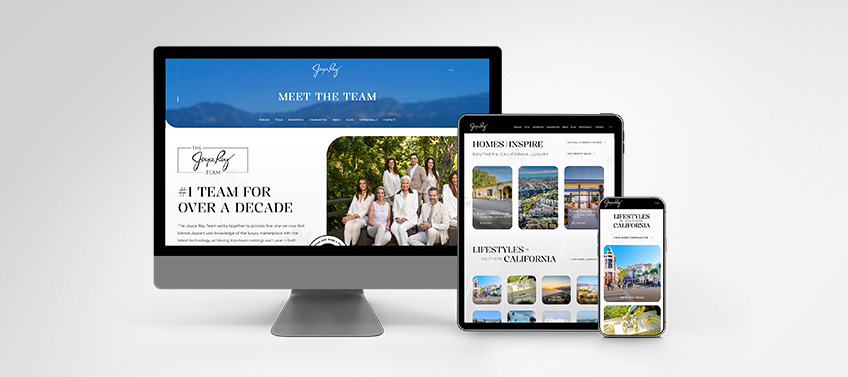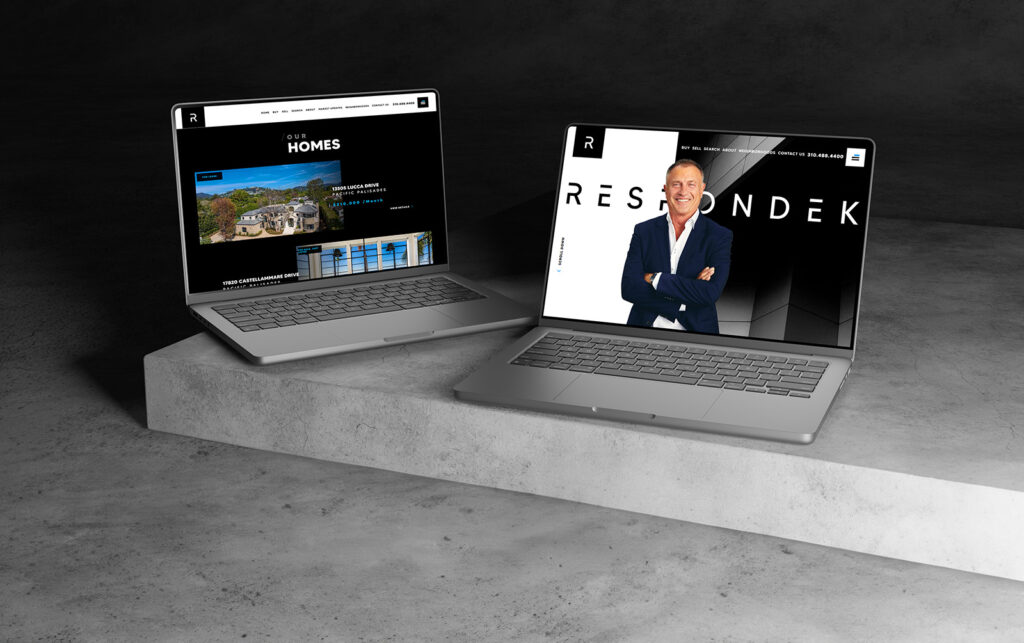The Blueprint for a Top-Tier Real Estate Website
Your website can be one of the hardest-working tools in your business. To make a strong impression, it needs clean design, smart information architecture, intuitive navigation, and up-to-date features that keep up with modern performance standards.
But how do you know which features are actually going to move the needle? This guide aims to answer that question. To keep things simple, we’ve broken it into two parts: the first covers the visual elements that visitors see when they land on your website, while the second dives into supporting features that bolster the user experience. Read on to learn more.
The Blueprint for a Top-Tier Real Estate Website
Key Elements of a High-Performing Website
Website Features that Drive Long-term Success

Key Elements of a High-Performing Website
Stunning Top Fold Design
You never get a second chance at a first impression—and in a website, the top fold is where that impression happens. If visitors don’t connect with what they see at the top, they’re unlikely to scroll any further. Your top fold has to catch people’s eye and invite them in, so make sure it’s confident, clear, and compelling.
One must-have is an engaging video banner, or high-quality images that capture the lifestyle, listings, and energy behind your brand. Your brand logo or tagline should also be front and center to instantly reinforce who you are and what you bring to the table.
Navigation-wise, stick to something simple and intuitive so visitors know exactly where to go next. Think clear links to your property search or buyer and seller guides.
Interactive Home Search Tools
Looking for a home is stressful enough as it is. Your website should make it as easy as possible for potential buyers. High-performing real estate websites should include key features such as:
-
A quick search bar
-
An interactive map search so users can browse visually, by location
-
Shortcuts to commonly searched categories such as price ranges, neighborhoods, or property types
Property Portfolio
A well-organized property portfolio helps clients find listings that matter without unnecessary clicks. Highlight featured homes, and consider organizing them by property type or lifestyle to help users find what fits their needs. You can also include recently sold properties to show your market activity and build trust with potential clients.
One important feature is IDX (Internet Data Exchange) integration. By adding IDX directly onto your website, visitors can view active listings straight from the MLS instead of turning to popular third-party platforms. This spells ease of use for customers, and keeping their attention on your website so they can contact you.

Pro Tip
Maximize lead capture on IDX pages by enabling user registration after a certain number of views. This serves as a way for visitors to save their searches and get listing alerts via email that match their criteria—and with this data, allowing you to keep in touch with their preferences.
Authentic Agent Profile
Done right, this page builds credibility, creates a sense of familiarity, and makes it easier for prospective clients to picture themselves working with you. The bio is your chance to highlight what sets you apart, whether it’s your local expertise, negotiation style, or decades of experience in a specific market.
Pair it with a professional (but personable) headshot to create a strong first impression, and include a clear summary of your credentials, specializations, and career highlights.
Success and Social Proof
Every relationship is built on trust, and the one you have with your clients is no exception. Adding customer testimonials, case studies, and even video reviews is one of the easiest ways to build trust and communicate your expertise. In the same vein, don’t shy away from putting your awards or success metrics front and center.
Active on social media? Increase engagement by integrating your profiles on your website. This gives users instant access to your latest posts and property tours, while also giving them another avenue to stay in touch with you.

Pro Tip
Include a few select quotes on your homepage to highlight your expertise and positive client experiences.
Real Estate Resources
Helpful content gives people a reason to stay on your website—and come back. Blog posts, market reports, and buyer or seller guides show that you understand the local market and the questions your clients are asking. Not only is this type of content great for attracting search engines (so clients can find you online!), but it also firmly establishes credibility so you become a go-to resource for all things real estate.
Intentional Lead Capture
Every visit to your website is a chance for potential clients to connect with you, but only if your site is actually set up to do it. That’s where intentional lead capture comes in.
-
Strategically-placed, straightforward buttons help guide users naturally through the site. Tell users exactly what you want them to do next, or where to go next on your website.
-
Contact forms work best when they’re located where people are already engaged, like listing pages, community guides, or blog posts.
-
Timed popups or slide-outs can be effective when they’re triggered after scrolling through a specific section, or given a precise time delay—making them proactive and relevant without being too intrusive.
Also, remember that not every visitor is looking for the same thing. A seller might respond to a home valuation tool, while a buyer might want to save a search. Tailored CTAs make the experience feel more personal and more effective.
Struggling to turn your website visitors into clients?
Let’s transform your site into a lead-generating powerhouse.
Website Features that Drive Long-term Success
Unique Brand Elements
Just like a home’s architecture and decor say a lot about who lives there, your website’s design speaks volumes about how you do business.
-
Consistent brand colors across your website help everything feel intentional and visually tied together.
-
Small touches like signature textures, patterns inspired by your logo, or icons that reflect your market make your site feel unique with design details thoughtfully considered.
-
Choice typography sets the overall feel for your brand. Using a consistent set of fonts throughout your site keeps it polished, readable, and professional.

On-Demand Communication
When someone is ready to reach out, there should be no guesswork involved. Keep your contact information easy to find within seconds—for example, placing it in the header and footer to ensure it’s always within reach. For mobile users, click-to-call buttons offer a quick way to connect on the go.
To take it even further, consider adding a live chat widget or chatbot. This automated tool can help answer questions in real time or collect leads after traditional business hours.
SEO-Optimized Content
Strong website copy should reflect your voice and speak directly to your ideal client. But it also needs to be discoverable. After all, what good is great content if no one can find it? Strategic keywords, quality backlinks, and a well-structured site help boost visibility on search engines.
On-page SEO, like proper meta descriptions, header tags, and alt text for images, is equally helpful in boosting visibility and engagement.

Pro Tip
To keep your website SEO-friendly, follow an SEO checklist that can help you evaluate your website’s search friendliness.
Speed and Performance
A faster site means better SEO, lower bounce rates, and a smoother experience all around. Consider compressing images and choosing a reliable host to keep your site quick, even with rich, high-quality visuals and search features. Trimming unnecessary code is another way to improve load times, especially for feature-heavy pages.
Analytics and CRM Integration
Tracking how people use your site helps you market smarter. With analytics and CRM tools in place, you can see what’s working—like which listings get views or which forms get filled—and adjust your strategy accordingly.
Security and Data Privacy
Last, but definitely not the least, is your website security. When potential clients visit your page, they should feel safe sharing contact information and browsing properties. A privacy policy on your website reassures clients and provides legal protection for your business.
Installing an SSL certificate secures your site and ensures GDPR and CCPA compliance if you’re collecting user data.

Pro Tip
Display security badges on your site and have a clear, accessible privacy policy that shows how visitor data is used and protected.
FREQUENTLY ASKED QUESTIONS
A website gives you control over your brand, serves as a 24/7 digital hub, and provides features that social media can’t, such as property search, IDX integration, and lead capture tools. Unlike social media, your website is solely focused on your services, which helps in building professionalism and credibility with potential clients.
Custom-designed websites are a fantastic way to showcase your unique brand, while also giving you complete creative freedom. But if you're looking for a quicker, more budget-friendly option without sacrificing quality, there are other options, too. Themed designs like our Agent Image X or Agent Pro websites are a great solution to get something launched without going through a drawn out design process.
Common call-to-action buttons include search homes, schedule a consultation, request a home valuation, contact me, get pre-approved, subscribe to my newsletter, and more.
If you’re having trouble getting started on your bio, try to glean inspiration from other agents. What information did they include, and how did they structure their narrative? Talk about your background, your local market expertise, and personal touches that can help clients connect with you as a real person. If you need a few more ideas or bio templates to start out, you can check out our how-to article that covers just that.
If you do end up using generative AI, think of it as a jumping-off point. Double-check crucial details, and make sure to personalize the language, voice, and tone—there’s a very real danger of sounding inauthentic or cliché when relying on AI for writing.
If all else fails, you can also hire an expert who can sort out all the copywriting for you.
If you’re still building your portfolio of happy clients, you can still present social proof by sharing professional endorsements, posting milestones (like homes sold or certifications earned), or highlighting the reputation of your brokerage.
Even if your social media presence isn't robust, you can still strategically showcase your online profiles. The key is quality over quantity: instead of linking every account that you have, carefully select one or two platforms that you regularly maintain so you can keep a professional image.
In general, you can keep your website fresh by updating listings in real-time, adding market insights monthly or quarterly, and refreshing your design every 2-3 years. It’s a big plus if you’re able to upload new content when you can, such as adding new team member profiles as they come along, or sharing informative blog articles that focus on local events. Updating your website signals how you engage with your greater community.
At Agent Image, our team takes care of these technical updates for you as part of your website hosting plan, so your content stays up-to-date and functions smoothly at all times.
Elevate your online presence with Agent Image
Building a high-performing real estate website requires expertise, strategy, and ongoing optimization—tasks that can be challenging without professional support. Agent Image specializes in creating impactful real estate websites that are not only beautiful but also functional—and memorable! From custom designs to advanced IDX integration and SEO, we understand what it takes to craft a top-tier digital presence that delights visitors and drives results for your real estate business.
Interested in learning more about Agent Image and what we can do for your real estate brand? Schedule a free consultation!






